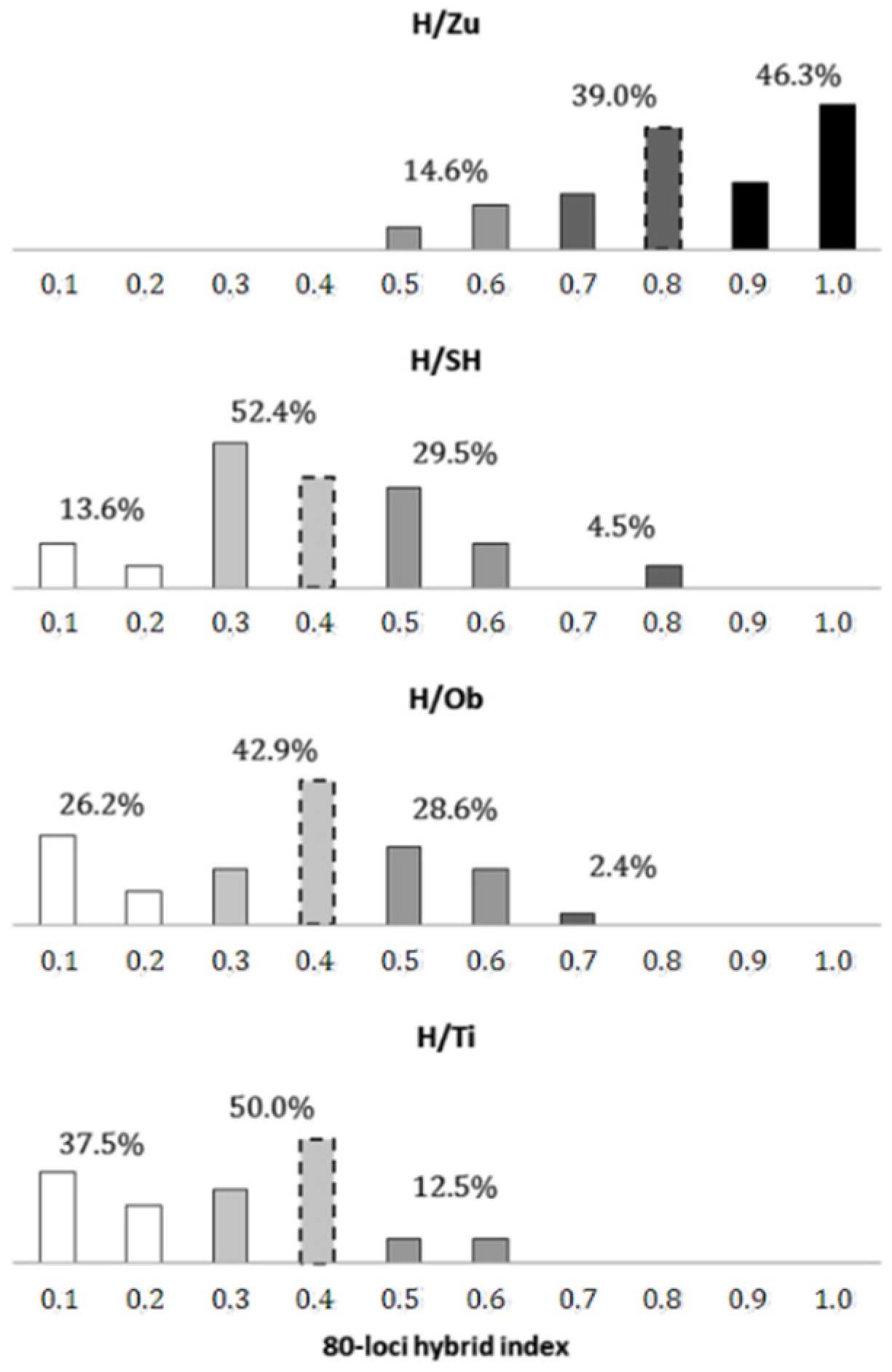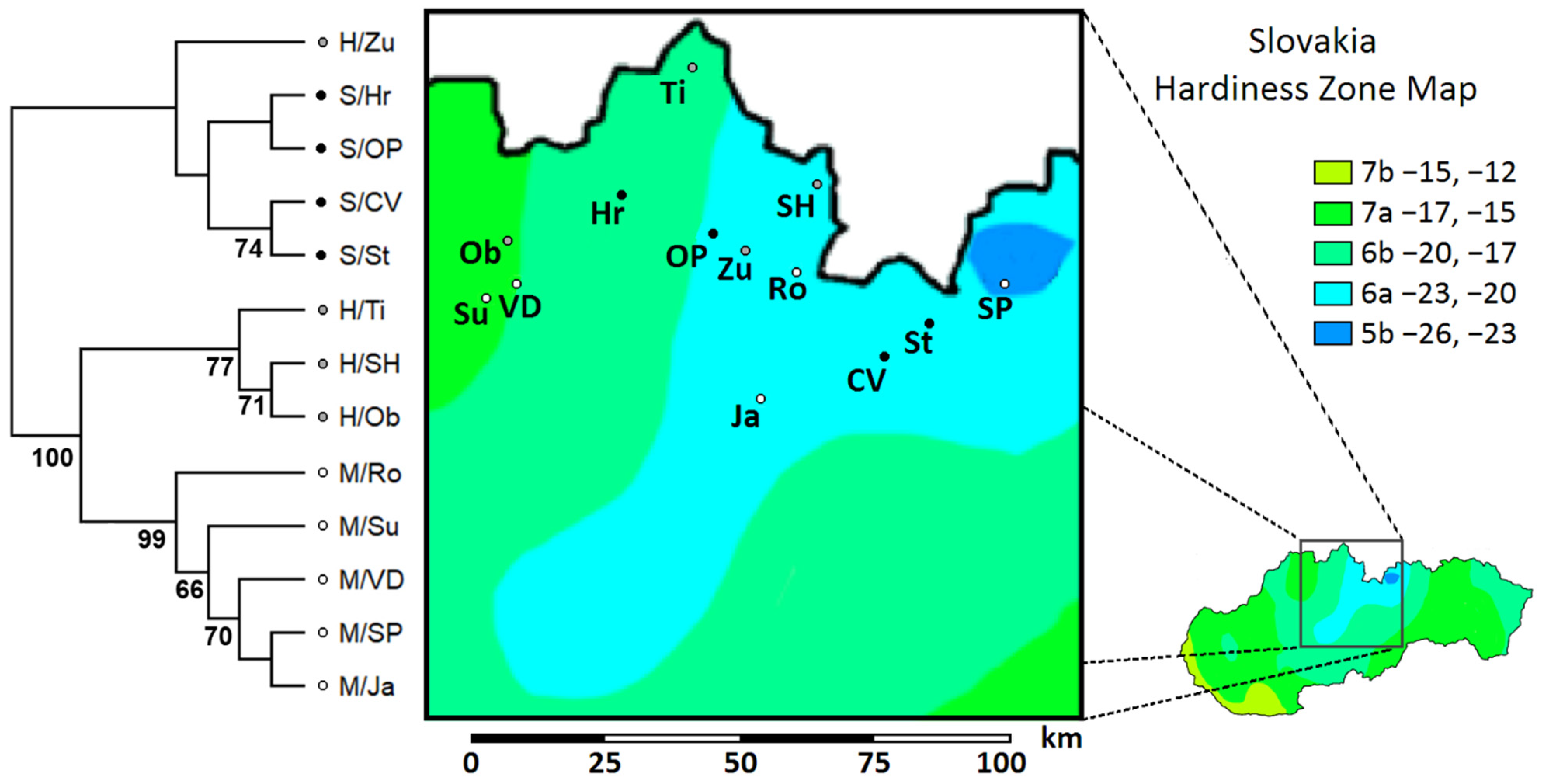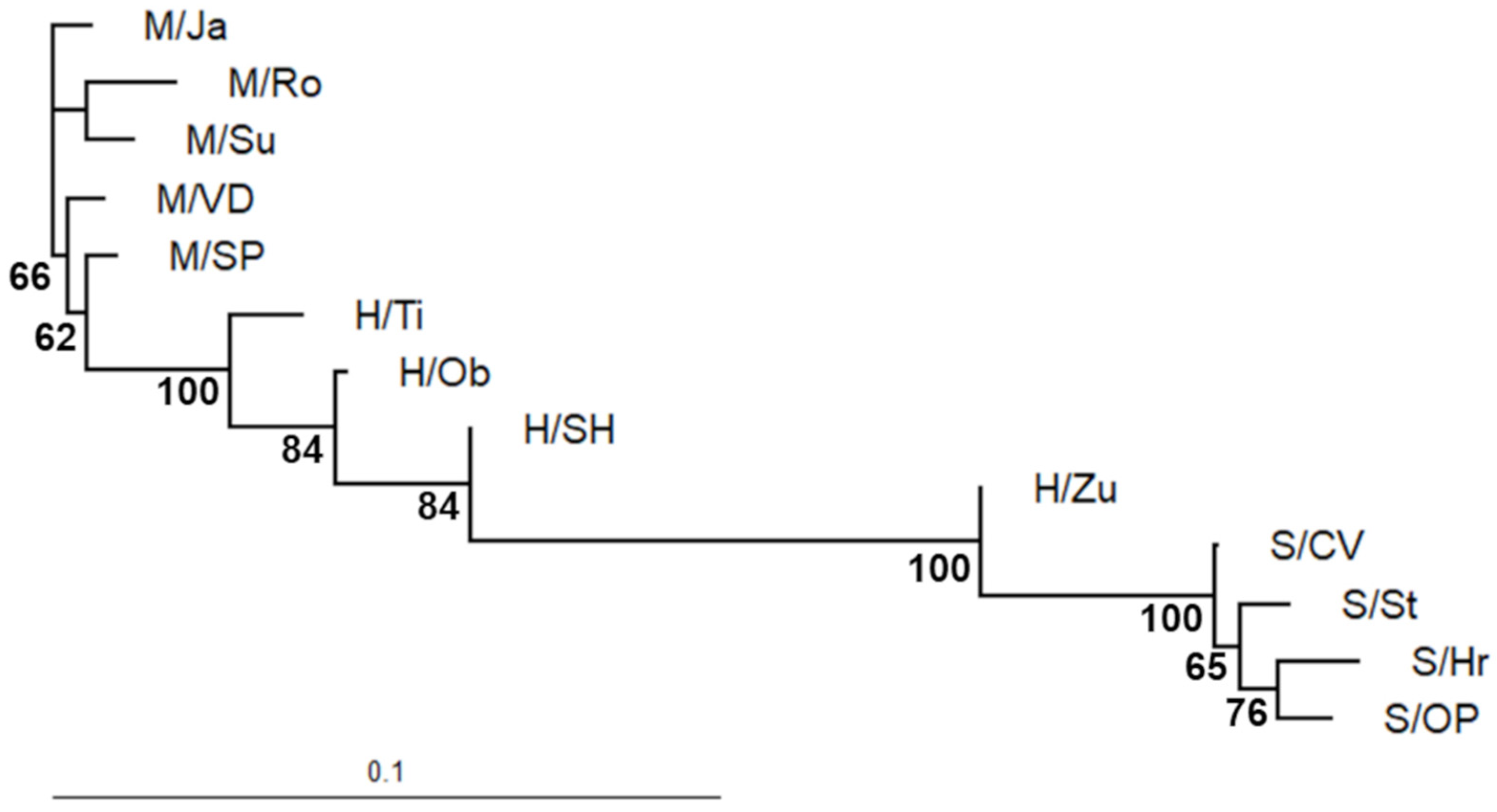Molecular Insight into Genetic Structure and Diversity of Putative Hybrid Swarms of Pinus sylvestris × P. mugo in Slovakia
Abstract
1. Introduction
2. Materials and Methods
2.1. Sampled Material and DNA Isolation
2.2. PCR Amplification
2.3. DNA Fragment Analysis and Data Collection
2.4. Statistics
3. Results
3.1. Population Genetic Variation
3.2. Population Genetic Structure
3.3. Genetic Differentiation and Phylogeny
3.4. Inter- and Intraspecific Differentiation by Individual iPBS Loci
4. Discussion
4.1. Within-Population Variation
4.2. Status of Hybrid Zone Populations
4.3. Genetic Differentiation and Phylogeny
5. Conclusions
Supplementary Materials
Author Contributions
Funding
Institutional Review Board Statement
Informed Consent Statement
Data Availability Statement
Acknowledgments
Conflicts of Interest
References
- Rieseberg, L.H.; Carney, S.E. Plant hybridization. New Phytol. 1998, 140, 599–624. [Google Scholar] [CrossRef] [PubMed]
- White, T.L.; Adams, W.T.; Neale, D.B. Forest Genetics; Cromwell Press Group: Trowbridge, UK, 2009. [Google Scholar]
- Abbott, R.; Albach, D.; Ansell, S.; Arntzen, J.W.; Baird, S.J.E.; Bierne, N.; Boughman, J.; Brelsford, A.; Buerkle, C.A.; Buggs, R.; et al. Hybridization and speciation. J. Evol. Biol. 2013, 26, 229–246. [Google Scholar] [CrossRef] [PubMed]
- Critchfield, W.B.; Little, E.L., Jr. Geographic Distribution of the Pines of the World; U.S. Department of Agriculture, Forest Service: Washington, DC, USA, 1966.
- Hamernik, J.; Musil, I. The Pinus mugo complex–its structuring and general overview of the used nomenclature. J. For. Sci. 2007, 53, 253–266. [Google Scholar] [CrossRef]
- Musil, I. Forest Dendrology 1–Conifers; Ceska Zemedelska Univerzita v Praze: Praha, Czech Republic, 2003. (In Czech) [Google Scholar]
- Businsky, R. Taxonomic studies on Pinus mugo aggr. and its hybrid populations. Acta Pruhoniciana 1999, 68, 123–144. (In Czech) [Google Scholar]
- Christensen, K.I. Taxonomic revision of the Pinus mugo complex and P. × rhaetica (P. mugo × P. sylvestris) (Pinaceae). Nord. J. Bot. 1987, 7, 383–408. [Google Scholar] [CrossRef]
- Christensen, K.I. A morphometric study of the Pinus mugo complex and its natural hybridization with P. sylvestris L. (Pinaceae). Feddes Repert. 1987, 98, 623–635. [Google Scholar] [CrossRef]
- Businsky, R. A new concept in bog pine. Zpravy Ces. Bot. Spolec. 2009, 44, 35–43. (In Czech) [Google Scholar]
- Labiszak, B.; Zaborowska, J.; Wachowiak, W. Patterns of mtDNA variation reveal complex evolutionary history of relict and endangered peat bog pine (Pinus uliginosa). AoB Plants 2019, 11, plz015. [Google Scholar] [CrossRef]
- Neet-Sarqueda, C. Genetic differentiation of Pinus sylvestris L. and Pinus mugo aggr. populations in Switzerland. Silvae Genet. 1994, 43, 207–215. [Google Scholar]
- Dobrinov, I. Study on natural hybrids between Pinus sylvestris and Pinus mugo var. mughus in Bulgaria. Nautschne Trudy Lesotechnitscheho Inst. 1965, 13, 39–48. (In Bulgarian) [Google Scholar]
- Dobrinov, I.; Jahzidis, G. Spontaneous hybrids between Pinus sylvestris and Pinus mugo in Bulgaria. Gorsko Stop. 1971, 11, 28–30. (In Bulgarian) [Google Scholar]
- Staszkiewicz, J. Natural hybrids of Pinus mugo × P. sylvestris (Pinaceae) in Tatra Mts. Fragm. Florist. Geobot. Ser. Pol. 1996, 3, 23–30. (In Polish) [Google Scholar]
- Staszkiewicz, J.; Tyszkiewicz, M. Natural hybrids of Pinus mugo Turra × Pinus silvestris L. in Nowy Targ valley. Fragm. Florist. Geobot. Ser. Pol. 1969, 15, 187–212. (In Polish) [Google Scholar]
- Kormutak, A.; Demankova, B.; Gomory, D. Spontaneous hybridization between Pinus sylvestris L. and P. mugo Turra in Slovakia. Silvae Genet. 2008, 57, 76–82. [Google Scholar] [CrossRef][Green Version]
- Kormutak, A.; Brana, M.; Manka, P.; Galgoci, M.; Libantova, J.; Camek, V.; Bolecek, P.; Gomory, D. Hybridization processes in putative hybrid swarms of scots pine and mountain dwarf pine as revealed by chloroplast DNA. Acta Biol. Crac. Ser. Bot. 2014, 56, 61–66. [Google Scholar] [CrossRef]
- Kormutak, A.; Galgoci, M.; Manka, P.; Koubova, M.; Jopcik, M.; Sukenikova, D.; Bolecek, P.; Gomory, D. Field-based artificial crossings indicate partial compatibility of reciprocal crosses between Pinus sylvestris and Pinus mugo and unexpected chloroplast DNA inheritance. Tree Genet. Genomes 2017, 13, 68. [Google Scholar] [CrossRef]
- Kormutak, A.; Galgoci, M.; Sukenikova, D.; Bolecek, P.; Libantova, J.; Gomory, D. Maternal inheritance of chloroplast DNA in Pinus mugo Turra: A case study of Pinus mugo × Pinus sylvestris crossing. Plant Syst. Evol. 2018, 304, 71–76. [Google Scholar] [CrossRef]
- Musil, I. Contribution to variability of the Pinus mugo s.l. complex in Slovakia. Variation of forest trees in Slovakia. In Proceedings of the XIIth Conference of the Forest Research Institute in Zvolen, Podbanske, Slovakia, 22–24 October 1975; pp. 249–269. (In Czech). [Google Scholar]
- Viewegh, J. Variability of the hybrid swarms Pinus mugo × Pinus sylvestris on peatbog in Zuberec, Orava. Folia Dendrol. 1981, 8, 41–59. (In Czech) [Google Scholar]
- Lanakova, M. Genotype structure of individuals of the Pinus mugo Turra and Pinus sylvestris L. hybrid complex. Folia Dendrol. 1992, 19, 339–352. [Google Scholar]
- Manka, P.; Kormutak, A.; Galgoci, M.; Gomory, D. Genetic status of the putative hybrid swarms of mountain dwarf pine and Scots pine in contact zones of their distribution in Slovakia. Biologia 2015, 70, 1318–1325. [Google Scholar] [CrossRef]
- Kalendar, R.; Antonius, K.; Smykal, P.; Schulman, A.H. iPBS: A universal method for DNA fingerprinting and retrotransposon isolation. Theor. Appl. Genet. 2010, 121, 1419–1430. [Google Scholar] [CrossRef] [PubMed]
- Murray, M.G.; Thompson, W.F. Rapid isolation of high molecular DNA. Nucleic Acid Res. 1980, 8, 4231–4235. [Google Scholar] [CrossRef] [PubMed]
- Lynch, M.; Milligan, B.G. Analysis of population genetic structure with RAPD markers. Mol. Ecol. 1994, 3, 91–99. [Google Scholar] [CrossRef] [PubMed]
- Nei, M. Analysis of gene diversity in subdivided populations. Proc. Natl. Acad. Sci. USA 1973, 70, 3321–3323. [Google Scholar] [CrossRef]
- Kimura, M.; Crow, J.F. The number of alleles that can be maintained in a finite population. Genetics 1964, 49, 725–738. [Google Scholar] [CrossRef]
- Ameijeiras-Alonso, J.; Crujeiras, R.M.; Rodriguez-Casal, A. Multimode: An R package for mode assessment. J. Stat. Softw. 2021, 97, 1–32. [Google Scholar] [CrossRef]
- Gregorius, H.-R.; Roberds, J.H. Measurement of genetical differentiation among subpopulations. Theor. Appl. Genet. 1986, 71, 826–834. [Google Scholar] [CrossRef]
- Nei, M. Estimation of average heterozygosity and genetic distance from a small number of individuals. Genetics 1978, 89, 583–590. [Google Scholar] [CrossRef]
- Wachowiak, W.; Palme, A.E.; Savolainen, O. Speciation history of three closely related pines Pinus mugo (T.), P. uliginosa (N.) and P. sylvestris (L.). Mol. Ecol. 2011, 20, 1729–1743. [Google Scholar] [CrossRef]
- Wachowiak, W.; Trivedi, U.; Perry, A.; Cavers, S. Comparative transcriptomics of a complex of four European pine species. BMC Genom. 2015, 16, 234. [Google Scholar] [CrossRef]
- Heuertz, M.; Teufel, J.; Gonzalez-Martinez, S.C.; Soto, A.; Fady, B.; Alia, R.; Vendramin, G.G. Geography determines genetic relationships between species of mountain pine (Pinus mugo complex) in western Europe. J. Biogeogr. 2010, 37, 541–556. [Google Scholar] [CrossRef]
- Celinski, K.; Kijak, H.; Wojnicka-Poltorak, A.; Buczkowska-Chmielewska, K.; Sokolowska, J.; Chudzinska, E. Effectiveness of the DNA barcoding approach for closely related conifers discrimination: A case study of the Pinus mugo complex. Comptes Rendus Biol. 2017, 340, 339–348. [Google Scholar] [CrossRef] [PubMed]
- Flegr, J. Evolutionary Biology; Academia: Praha, Czech Republic, 2005. (In Czech) [Google Scholar]
- Bobowicz, M.A.; Danielewicz, W.; Pieczynska, B.; Wojnicka-Poltorak, A.; Prus-Glowacki, W. Isoenzymatic variability in progeny of Pinus mugo Turra × Pinus sylvest ris L. hybrids from Bor na Czerwonem, in experimental culture. Acta Soc. Pol. 2000, 69, 137–144. [Google Scholar] [CrossRef]
- Staszkiewicz, J.; Tyszkiewicz, M. Variability of natural hybrids between Pinus silvestris L. x Pinus mugo Turra (P. rotundata Link) in south-western Poland and in some localities in Czech Republic and Moravia. Fragm. Florist. Geobot. 1972, 18, 173–191. [Google Scholar]
- Musil, I. Needle variation in the complex Pinus mugo and Pinus sylvestris. Preslia 1977, 49, 23–32. [Google Scholar]
- Buerkle, C.A. Maximum-likelihood estimation of a hybrid index based on molecular markers. Mol. Ecol. Notes 2005, 5, 684–687. [Google Scholar] [CrossRef]
- Jiggins, C.D.; Mallet, J. Bimodal hybrid zones and speciation. Trends Ecol. Evol. 2000, 15, 250–255. [Google Scholar] [CrossRef]
- Wachowiak, W.; Odrzykoski, I.; Myczko, L.; Prus-Glowacki, W. Lack of evidence on hybrid swarm in the sympatric population of Pinus mugo and P. sylvestris. Flora 2006, 201, 307–316. [Google Scholar] [CrossRef]
- Wachowiak, W.; Prus-Glowacki, W. Hybridisation processes in sympatric populations of pines Pinus sylvestris L., P. mugo Turra and P. uliginosa Neumann. Plant Syst. Evol. 2008, 271, 29–40. [Google Scholar] [CrossRef]
- Wachowiak, W.; Zukowska, W.B.; Wojkiewicz, B.; Cavers, S.; Litkowiec, M. Hybridization in contact zone between temperate European pine species. Tree Genet. Genomes 2016, 12, 48. [Google Scholar] [CrossRef]
- Lewandowski, A.; Boratynski, A.; Mejnartowicz, L. Allozyme investigations on the genetic differentiation between closely related pines-Pinus sylvestris, P. mugo, P. uncinata, and P. uliginosa (Pinaceae). Plant Syst. Evol. 2000, 221, 15–24. [Google Scholar] [CrossRef]
- Boratynska, K.; Boratynski, A. Taxonomic differences among closely related pines Pinus sylvestris, P. mugo, P. uncinata, P. rotundata and P. uliginosa as revealed in needle sclerenchyma cells. Flora 2007, 202, 555–569. [Google Scholar] [CrossRef]





| Locality | Abbr. | Area | Region | GPS Coordinates | Altitude | Subsoil |
|---|---|---|---|---|---|---|
| P. sylvestris | ||||||
| Hrustin | S/Hr | - | Orava | 49°20′ N; 19°19′ E | 830 m | mineral |
| Cierny Vah | S/CV | - | Nizke Tatry | 49°00′ N; 19°56′ E | 790 m | mineral |
| Oravsky Biely Potok | S/OP | - | Orava | 49°17′ N; 19°32′ E | 735 m | mineral |
| Strba | S/St | - | Vysoke Tatry | 49°07′ N; 20°03′ E | 1410 m | mineral |
| Hybrid swarms | ||||||
| Zuberec (Medzi bormi) | H/Zu | 6 ha | Orava | 49°16′ N; 19°37′ E | 817 m | peatbog |
| Sucha Hora (Rudne) | H/SH | 2 ha | Orava | 49°23′ N; 19°47′ E | 750 m | peatbog |
| Terchova (Obsivanka) | H/Ob | 21 ha | Mala Fatra | 49°14′ N; 19°01′ E | 840 m | mineral |
| Oravska Polhora (Tisovnica) | H/Ti | 15 ha | Orava | 49°33′ N; 19°23′ E | 745 m | peatbog |
| P. mugo | ||||||
| Rohace | M/Ro | - | Zapadne Tatry | 49°12′ N; 19°45′ E | 1465 m | mineral |
| Suchy | M/Su | - | Mala Fatra | 49°10′ N; 18°57′ E | 1412 m | mineral |
| Vratna dolina | M/VD | - | Mala Fatra | 49°11′ N; 19°02′ E | 1280 m | mineral |
| Skalnate Pleso | M/SP | - | Vysoke Tatry | 49°11′ N; 20°14′ E | 1734 m | mineral |
| Jasna | M/Ja | - | Nizke Tatry | 48°57′ N; 19°34′ E | 1546 m | mineral |
| Primer | Length [nt] | Sequence | TM [°C] | CG [%] | TA [°C] |
|---|---|---|---|---|---|
| 2077 | 12 | 5′-CTCACGATGCCA-3′ | 46.1 | 58.3 | 55.1 |
| 2080 | 12 | 5′-CAGACGGCGCCA-3′ | 54.6 | 75.0 | 63.3 |
| 2083 | 12 | 5′-CTTCTAGCGCCA-3′ | 45.7 | 58.3 | 54.6 |
| 2374 | 12 | 5′-CCCAGCAAACCA-3′ | 47.1 | 58.3 | 53.5 |
| 2378 | 12 | 5′-GGTCCTCATCCA-3′ | 44.2 | 58.3 | 53.0 |
| 2224 | 18 | 5′-ATCCTGGCAATGGAACCA-3′ | 56.6 | 50.0 | 55.4 |
| 2237 | 18 | 5′-CCCCTACCTGGCGTGCCA-3′ | 65.0 | 72.2 | 55.0 |
| 2239 | 18 | 5′-ACCTAGGCTCGGATGCCA-3′ | 60.4 | 61.1 | 55.0 |
| 2242 | 18 | 5′-GCCCCATGGTGGGCGCCA-3′ | 69.2 | 77.8 | 57.0 |
| 2373 | 18 | 5′-GAACTTGCTCCGATGCCA-3′ | 57.9 | 55.6 | 51.0 |
| Within-Population Variation | Among-Population Variation | ||||||
|---|---|---|---|---|---|---|---|
| Pop. | N ± SD | nA ± SD | HE ± SD | nE ± SD | GST | DK(S) ± SD | DK(M) ± SD |
| S/Hr | 31 ±0 | 1.86 ± 0.35 | 0.25 ± 0.18 | 1.41 ± 0.35 | 0.0377 | - | - |
| S/CV | 34 ± 0 | 1.91 ± 0.28 | 0.27 ± 0.17 | 1.44 ± 0.33 | - | - | |
| S/OP | 30 ± 0 | 1.86 ± 0.35 | 0.27 ± 0.17 | 1.44 ± 0.34 | - | - | |
| S/St | 35 ± 0 | 1.90 ± 0.30 | 0.28 ± 0.17 | 1.46 ± 0.34 | - | - | |
| WM | 1.89 ± 0.03 | 0.27 ± 0.01 | 1.44 ± 0.02 | ||||
| H/Zu | 39 ± 2 | 1.96 ± 0.19 | 0.31 ± 0.16 | 1.52 ± 0.33 | 0.0799 | 0.10 ± 0.10 | 0.23 ± 0.19 |
| H/SH | 44 ± 0 | 1.98 ± 0.16 | 0.32 ± 0.16 | 1.55 ± 0.34 | 0.19 ± 0.15 | 0.13 ± 0.11 | |
| H/Ob | 42 ± 0 | 1.94 ± 0.24 | 0.31 ± 0.17 | 1.53 ± 0.35 | 0.21 ± 0.16 | 0.12 ± 0.12 | |
| H/Ti | 48 ± 0 | 1.99 ± 0.11 | 0.33 ± 0.15 | 1.57 ± 0.33 | 0.23 ± 0.18 | 0.12 ± 0.11 | |
| WM | 1.97 ± 0.02 | 0.32 ± 0.01 | 1.54 ± 0.02 | ||||
| M/Ro | 33 ± 0 | 1.83 ± 0.38 | 0.27 ± 0.19 | 1.46 ± 0.38 | 0.0383 | - | - |
| M/Su | 34 ± 0 | 1.86 ± 0.35 | 0.27 ± 0.18 | 1.45 ± 0.34 | - | - | |
| M/VD | 42 ± 1 | 1.95 ± 0.22 | 0.30 ± 0.17 | 1.51 ± 0.34 | - | - | |
| M/SP | 35 ± 0 | 1.95 ± 0.22 | 0.29 ± 0.17 | 1.47 ± 0.34 | - | - | |
| M/Ja | 40 ± 0 | 1.95 ± 0.22 | 0.30 ± 0.17 | 1.49 ± 0.33 | - | - | |
| WM | 1.91 ± 0.06 | 0.28 ± 0.01 | 1.48 ± 0.02 | ||||
| S/Hr | S/CV | S/OP | S/St | H/Zu | H/SH | H/Ob | H/Ti | M/Ro | M/Su | M/VD | M/SP | M/Ja | |
|---|---|---|---|---|---|---|---|---|---|---|---|---|---|
| S/Hr | |||||||||||||
| S/CV | 0.012 | ||||||||||||
| S/OP | 0.014 | 0.012 | |||||||||||
| S/St | 0.019 | 0.007 | 0.015 | ||||||||||
| H/Zu | 0.027 | 0.031 | 0.033 | 0.032 | |||||||||
| H/SH | 0.096 | 0.082 | 0.091 | 0.091 | 0.057 | ||||||||
| H/Ob | 0.112 | 0.093 | 0.105 | 0.109 | 0.073 | 0.024 | |||||||
| H/Ti | 0.139 | 0.122 | 0.131 | 0.128 | 0.080 | 0.028 | 0.038 | ||||||
| M/Ro | 0.246 | 0.218 | 0.235 | 0.231 | 0.162 | 0.052 | 0.052 | 0.052 | |||||
| M/Su | 0.239 | 0.201 | 0.227 | 0.217 | 0.159 | 0.050 | 0.050 | 0.047 | 0.015 | ||||
| M/VD | 0.198 | 0.173 | 0.194 | 0.185 | 0.125 | 0.035 | 0.040 | 0.034 | 0.020 | 0.015 | |||
| M/SP | 0.201 | 0.169 | 0.198 | 0.180 | 0.128 | 0.036 | 0.034 | 0.033 | 0.021 | 0.014 | 0.010 | ||
| M/Ja | 0.218 | 0.191 | 0.215 | 0.202 | 0.142 | 0.041 | 0.044 | 0.036 | 0.020 | 0.011 | 0.009 | 0.009 |
| Number/ Name of Loci | pS ± SD | pM ± SD | DK | GST(S) | GST(M) | GST(SM) |
|---|---|---|---|---|---|---|
| 13 (16.25%) | <0.05 | |||||
| 35 (43.75%) | 0.05–0.15 | |||||
| 14 (17.50%) | 0.15–0.25 | |||||
| 18 (22.50%) | >0.25 | |||||
| Total (100%) | 0.2120 | |||||
| 2373–1040 bp | 0.13 ± 0.01 | 1.00 ± 0.00 | 0.87 | 0.0011 | - | 0.7853 |
| 2374–540 bp | 1.00 ± 0.00 | 0.04 ± 0.01 | 0.96 | - | 0.0047 | 0.9206 |
Publisher’s Note: MDPI stays neutral with regard to jurisdictional claims in published maps and institutional affiliations. |
© 2022 by the authors. Licensee MDPI, Basel, Switzerland. This article is an open access article distributed under the terms and conditions of the Creative Commons Attribution (CC BY) license (https://creativecommons.org/licenses/by/4.0/).
Share and Cite
Klobucnik, M.; Galgoci, M.; Gomory, D.; Kormutak, A. Molecular Insight into Genetic Structure and Diversity of Putative Hybrid Swarms of Pinus sylvestris × P. mugo in Slovakia. Forests 2022, 13, 205. https://doi.org/10.3390/f13020205
Klobucnik M, Galgoci M, Gomory D, Kormutak A. Molecular Insight into Genetic Structure and Diversity of Putative Hybrid Swarms of Pinus sylvestris × P. mugo in Slovakia. Forests. 2022; 13(2):205. https://doi.org/10.3390/f13020205
Chicago/Turabian StyleKlobucnik, Miroslav, Martin Galgoci, Dusan Gomory, and Andrej Kormutak. 2022. "Molecular Insight into Genetic Structure and Diversity of Putative Hybrid Swarms of Pinus sylvestris × P. mugo in Slovakia" Forests 13, no. 2: 205. https://doi.org/10.3390/f13020205
APA StyleKlobucnik, M., Galgoci, M., Gomory, D., & Kormutak, A. (2022). Molecular Insight into Genetic Structure and Diversity of Putative Hybrid Swarms of Pinus sylvestris × P. mugo in Slovakia. Forests, 13(2), 205. https://doi.org/10.3390/f13020205







